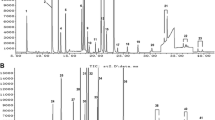Abstract
A fast pesticide multiresidue analysis method using gas chromatography coupled with electron capture detector was investigated for the simultaneous determination of 15 organochlorine pesticides (OCPs) in American ginseng (Panax quinquefolium L.). Samples were extracted with acetic acid–water–acetonitrile (1:5:94, v/v) and cleaned up by the Quick Easy Cheap Effective Rugged and Safe multiresidue method (QuEChERS). The linearity for 15 OCPs, in the working standard solutions of seven concentration levels between 1 and 100 ng/ml, varied from 0.9990 to 0.9999. Recoveries at concentrations between 0.1 and 2 μg/g ranged from 81.4 to 95.2%, with precision, which was expressed as relative standard deviation (RSD), at values lower than 8.0%. The proposed method was applied to the determination of pesticide levels from 60 samples, taken from six different areas. Among a total of 60 samples, 15.0% (9 samples) contained at least one of the 15 pesticides. The 15 OCPs were benzene hexachloride (BHC, including α-BHC, β-BHC, γ-BHC, δ-BHC), hexachlorobenzene, heptachlor, heptachlor epoxide, aldrin, p,p′-DDE, p,p′-DDD, o,p′-DDT, p,p′-DDT, mirex, endrin and dieldrin. This study indicates that the proposed method is useful for analyzing OCPs in American ginseng.

Similar content being viewed by others
References
Yuan CS, Anoja SA, Wu JA, Liu D (1998) Modulation of American ginseng on brainstem GABAergic effects in rats. J Ethnopharmacol 62:215–222
Kyung TK, Kyung MY, Jin WL, Seok HE, In KH, Chang YL (2007) Protective effect of steamed American ginseng (Panax quinquefolius L.) on V79–4 cells induced by oxidative stress. J Ethnopharmacol 111:443–450
Erin MS, Marla SM (2006) Ginsenoside content and variation among and within American ginseng (Panax quinquefolius L.) populations. Phytochemistry 67:1510–1519
Rebecca C, Stephen E, Mandy LK, Laura LM (2006) The influence of lead and arsenite on the inhibition of human breast cancer MCF-7 cell proliferation by American ginseng root (Panax quinquefolius L.). Life Sci 78:1336–1340
Vagi MC, Petsas AS, Kostopoulou MN, Karamanoli MK, Lekkas TD (2007) Determination of organochlorine pesticides in marine sediments samples using ultrasonic solvent extraction followed by GC/ECD. Desalination 210:146–156
Barriada PM, Concha GE (2003) Microwave-assisted extraction versus Soxhlet extraction in the analysis of 21 organochlorine pesticides in plants. J Chromatogr A 1008:115–122
Ling YC, Teng HC, Cartwright C (1999) Supercritical fluid extraction and clean-up of organochlorine pesticides in Chinese herbal medicine. J Chromatogr A 835:145–157
China Pharmacopoeia Committee (2010) Chinese Pharmacopoeia. Chemical Industry Press, Beijing
Yoshioka N, Akiyama Y, Mitsuhashi T, Hatanaka H, Tsuji M, Matsushita S (2000) Analysis of pesticide residues in ginseng and senna. Iyakuhin Kenkyu 31:225–231
Shioda S, Hamano T, Nakajima J, Shimomura J, Suetsugu D, Yasuda I (2004) Organophosphorus and pyrethroid pesticide residues in the crude drugs and the decoction. Annu Rep Tokyo Metrop Inst Public Health 55:43–47
Sato M, Anetai M, Goda Y (2005) Analysis of organophosphorus pesticide residues in crude drugs. Iyakuhin Kenkyu 36:83–97
Anastassiades M, Lehotay SJ, Stajnbaher D, Schenck FJ (2003) Fast and easy multiresidue method employing acetonitrile extraction/partitioning and “dispersive solid-phase extraction” for the determination of pesticide residues in produce. J AOAC Int 86:412–431
Schenck FJ, Hobbs JE (2004) Evaluation of the quick, easy, cheap, effective, rugged, and safe (QuEChERS) approach to pesticide residue analysis. Bull Environ Contam Toxicol 73:24–30
Lehotay SJ, Mastovská K, Yun SJ (2005) Evaluation of two fast and easy methods for pesticide residue analysis in fatty food matrixes. J AOAC Int 88:630–638
Diez C, Traag WA, Zommer P, Marinero P, Atienza J (2006) Comparison of an acetonitrile extraction/partitioning and “dispersive solid-phase extraction” method with classical multi-residue methods for the extraction of herbicide residues in barley samples. J Chromatogr A 1131:11–23
Hercegova A, Domotorova M, Kruzlicova D, Matisova E (2006) Comparison of sample preparation methods combined with fast gas chromatography-mass spectrometry for ultratrace analysis of pesticide residues in baby food. J Sep Sci 29:1102–1109
Looser N, Kostelac D, Scherbaum E, Anastassiades M, Zipper H (2006) Pesticide residues in strawberries sampled from the market of the Federal State of Baden-Württemberg in the period between 2002 and 2005. J Verbr Lebensm 1:135–141
Barakat AA, Badawy HMA, Salama E, Attallah E, Maatook G (2007) Simple and rapid method of analysis for determination of pesticide residues in honey using dispersive solid phase extraction and GC determination. J Food Agric Environ 5:97–100
Payá P, Anastassiades M, Mack D, Sigalova I, Tasdelen B, Oliva J, Barba A (2007) Analysis of pesticide residues using the Quick Easy Cheap Effective Rugged and Safe (QuEChERS) pesticide multiresidue method in combination with gas and liquid chromatography and tandem mass spectrometric detection. Anal Bioanal Chem 389:1697–1714
Anastassiades M, Tasdelen B, Scherbaum E, Stajnbaher D (2007) Recent developments in QuEChERS methodology for pesticide multiresidue analysis. In: Ohkawa H, Miyagawa H, Lee PW (eds) Pesticide chemistry: crop protection, public health, environmental safety. Wiley-VCH, Weinheim
Acknowledgments
We thank the China National Group Corporation of Traditional and Herbal Medicine for encouraging us to continue our survey. We are also grateful to Yuzhen Ren, Xiujuan Peng and Yuqi Wang for technical support. This work was supported by grant 2004DIB1J039 from the Ministry of Science and Technology of the People’s Republic of China.
Author information
Authors and Affiliations
Corresponding author
Rights and permissions
About this article
Cite this article
Wu, J., Liu, Y., Zhao, R. et al. Fast pesticide multiresidue analysis in American ginseng (Panax quinquefolium L.) by gas chromatography with electron capture detection. J Nat Med 65, 406–409 (2011). https://doi.org/10.1007/s11418-010-0500-z
Received:
Accepted:
Published:
Issue Date:
DOI: https://doi.org/10.1007/s11418-010-0500-z




